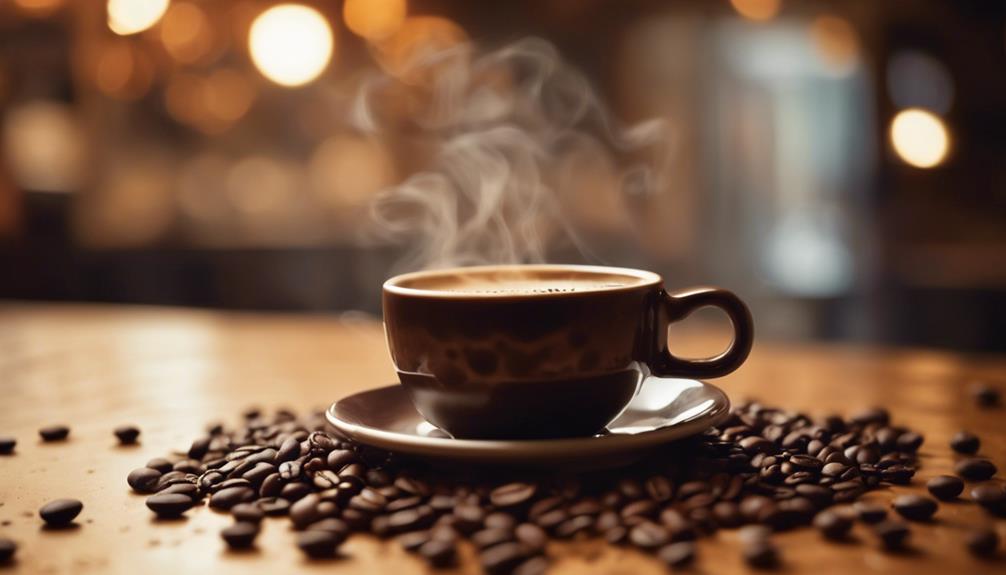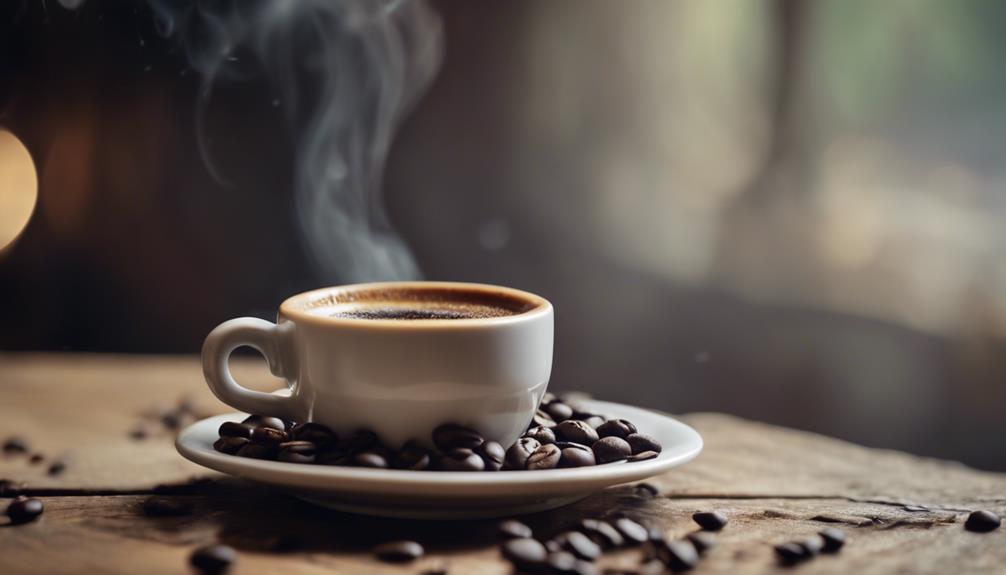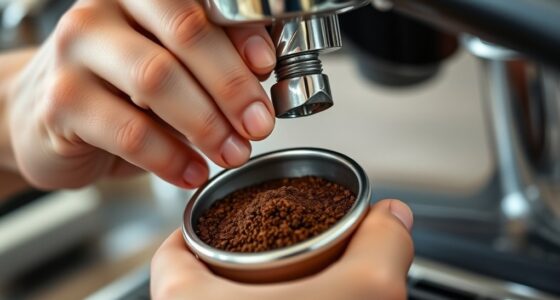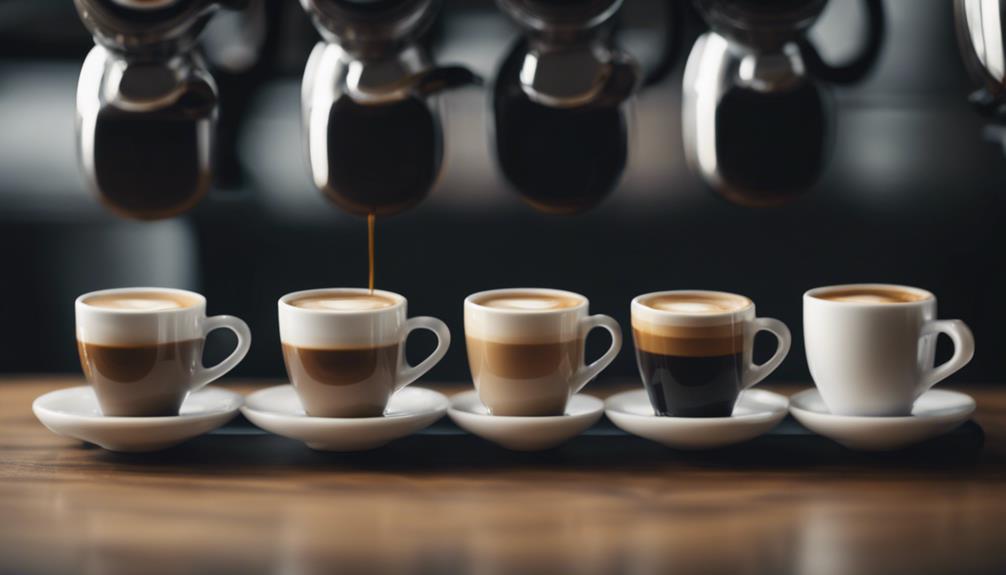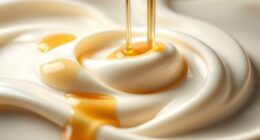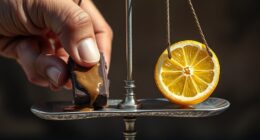You are probably consuming about 63 milligrams of caffeine with each regular 1-ounce shot of espresso you have. A double shot contains around 125 milligrams, while specialty drinks can increase that amount even further. However, caffeine levels can vary significantly depending on factors such as the type of coffee beans used, the grind size, and brewing techniques. Serving size also plays a role, as a single shot typically has less total caffeine than an 8-ounce brewed coffee. Now that you have a basic understanding, you might be curious about how these factors impact your favorite espresso beverages – and we are just scratching the surface.
Key Takeaways
- A standard 1-ounce shot of espresso contains approximately 63 mg of caffeine.
- Espresso has higher caffeine per ounce compared to brewed coffee, which averages between 95-128 mg per 8 ounces.
- Serving size significantly affects overall caffeine intake, with a single shot of espresso typically having less total caffeine than an 8-ounce brewed coffee.
- Caffeine levels can vary based on the type of espresso drink, such as lattes, cappuccinos, and Americanos, with added flavors or extra shots increasing caffeine content.
Caffeine Content in Espresso
When you order a shot of espresso, you can expect a concentrated dose of caffeine, with a standard 1-ounce serving packing around 63 milligrams of the stimulant.
But that's not all – a double shot, also known as a doppio, typically contains around 125 milligrams of caffeine.
The type of coffee beans used can also impact the caffeine content, with Robusta beans generally having about twice the caffeine of Arabica beans.
Factors like grind size, brewing time, and pressure during extraction greatly influence the caffeine levels in espresso.
Despite its concentrated nature, a single shot of espresso usually has less total caffeine than an 8-ounce cup of brewed coffee, which averages around 95 milligrams of caffeine.
So, what does this mean for you? Be mindful of the amount of caffeine you're consuming, especially if you're sensitive to its effects.
How Coffee Beans Affect Caffeine
You might be surprised to learn that the type of coffee bean you use can greatly alter the caffeine content of your espresso. The type of bean, roast level, grind size, and brewing method all play an important role in determining the caffeine content of your shot.
Here are some key factors to take into account:
- Bean type: Robusta beans contain approximately twice the caffeine of Arabica beans, so your choice of bean can greatly impact your caffeine intake.
- Roast level: Darker roasts generally have lower caffeine levels than lighter roasts, as the prolonged roasting process breaks down caffeine molecules.
- Grind size: The grind size of your coffee beans affects caffeine extraction, with finer grinds increasing the surface area and enhancing caffeine transfer during brewing.
- Environmental factors: Growing conditions and altitude can influence the caffeine concentrations in coffee beans, so it's worth taking into account the origin of your beans.
Espresso Vs Coffee Caffeine Levels
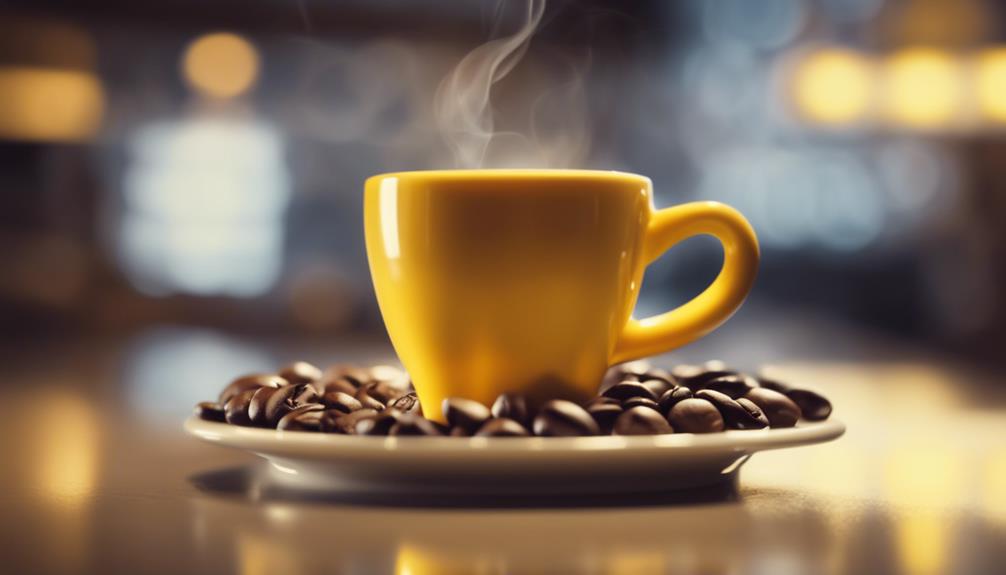
When you compare the caffeine content of espresso and coffee, you might be surprised to find that espresso packs a bigger punch per ounce. You'll typically get around 63 mg of caffeine in a 1-ounce shot of espresso, whereas an 8-ounce cup of brewed coffee contains around 95-128 mg.
But what does this mean for your daily caffeine intake, and how do these numbers stack up when you consider serving sizes?
Espresso Caffeine Content
How much caffeine can you expect from a shot of espresso compared to a cup of brewed coffee? Let's explore the facts.
When it comes to espresso caffeine content, here are some key points to evaluate:
- A standard 1-ounce shot of espresso contains approximately 63 mg of caffeine, while a double shot (2 ounces) contains about 126 mg.
- The type of coffee bean used affects the caffeine content, with Robusta beans containing about twice the caffeine of Arabica beans.
- Brewing methods also influence caffeine levels, as espresso extraction utilizes high pressure and fine grind size, leading to higher caffeine transfer than many traditional brewing methods.
- Despite its higher concentration, people often consume espresso in smaller volumes, resulting in lower overall caffeine intake compared to larger servings of brewed coffee.
In essence, a shot of espresso contains a significant amount of caffeine per serving, but the concentration of caffeine can vary depending on the coffee bean type and brewing methods used.
While espresso has a higher caffeine content per ounce, the overall caffeine intake is often lower due to the smaller serving size.
Coffee Caffeine Comparison
Comparing the caffeine content of espresso and brewed coffee reveals some interesting differences. A standard 1-ounce shot of espresso packs approximately 63 mg of caffeine, while an average 8-ounce cup of brewed coffee contains around 95 mg.
You might assume that espresso has a higher caffeine level due to its concentrated form, but that's not always the case. When you consider the serving size, brewed coffee can have a higher caffeine content overall.
However, if you're comparing a double shot of espresso (2 ounces) to a larger serving of brewed coffee, the caffeine content can be comparable or even exceed that of the coffee. Factors that influence the caffeine content in both espresso and coffee include the type of coffee bean, preparation method, and serving size.
For instance, drip brewed coffee made from Robusta beans can contain up to 200 mg of caffeine per 6 ounces, surpassing the caffeine content found in espresso servings.
Caffeine in Popular Espresso Drinks
As you explore the world of espresso-based drinks, you're probably wondering how much caffeine you're getting in each cup.
Let's take a closer look at the caffeine content in popular espresso drinks, starting with lattes, where the amount of caffeine varies depending on the size.
You'll also discover the surprising differences in caffeine levels between cappuccinos and Americanos.
Caffeine in Lattes
When you order a latte, you can expect a boost of energy from the caffeine, which typically ranges from 75 mg to 150 mg depending on the number of espresso shots used.
Here are some key facts to keep in mind about caffeine in lattes:
- A standard latte with a single shot of espresso contains around 75 mg of caffeine.
- A double shot increases the caffeine content to approximately 150 mg.
- The caffeine content can vary based on the size, such as a grande latte at Starbucks with two shots of espresso, which contains about 150 mg of caffeine.
- Adding flavored syrups or ingredients, like chocolate in a mocha, can increase the caffeine up to 180 mg.
It's worth noting that the caffeine in a latte primarily comes from the espresso shots, so the number of shots directly affects the total caffeine content.
Compared to brewed coffee, lattes generally have less caffeine per ounce, but the concentrated caffeine in espresso still provides a significant energy boost.
Espresso in Cappuccinos
Ordering a cappuccino typically means you'll get a boost of energy from one shot of espresso, which packs around 75 mg of caffeine in a short or tall size.
However, the total caffeine amount can vary depending on the amount of espresso used. If you opt for a grande or venti size, you'll get around 150 mg of caffeine from the two shots of espresso.
Keep in mind that cappuccinos usually consist of equal parts espresso, steamed milk, and milk foam, but the caffeine primarily comes from the espresso component.
If you're looking for an extra kick, some cappuccinos can include a double shot of espresso, bringing the total caffeine content up to 150 mg, comparable to a strong brewed coffee.
Specialty variations of cappuccinos, such as those with added flavors or chocolate, can increase the caffeine content further, particularly if they incorporate additional espresso shots.
Caffeine in Americanos
You'll get a similar caffeine boost from an Americano as you'd from a cappuccino, but the preparation method sets them apart. When you order an Americano, you can expect a rich, intense flavor profile due to the espresso base. But how much caffeine are you really getting?
Here are some key facts to keep in mind:
- A short Americano made with a single shot of espresso contains approximately 75 mg of caffeine.
- A medium Americano with a double shot can contain up to 150 mg of caffeine.
- A venti Americano from Starbucks can reach as high as 300 mg due to the use of multiple espresso shots.
- Variations in Americano preparation, such as using different espresso shots or water ratios, can lead to significant differences in caffeine content.
Compared to brewed coffee, an Americano has a similar caffeine concentration but offers a more intense flavor profile. The strength of an Americano comes from the dilution of espresso with hot water, which preserves the espresso's concentrated caffeine while increasing the overall volume.
Factors Influencing Caffeine Content
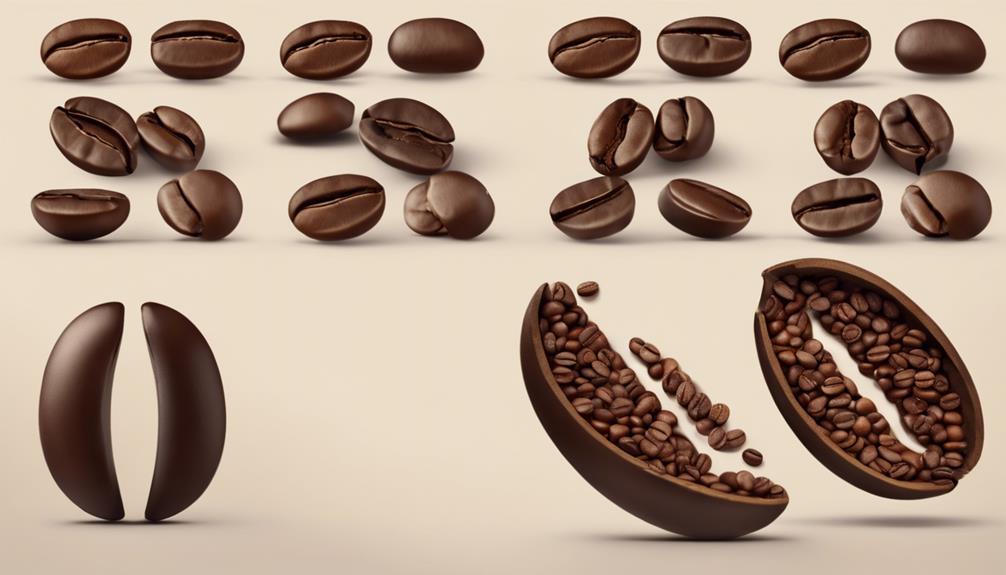
Several factors contribute to the varying levels of caffeine in your espresso shots, and understanding these influences is key to customizing your perfect cup. You might be surprised to learn that the type of coffee beans used, the grind size, brewing time, roasting process, and amount of coffee used all play a significant role in determining the caffeine content of your espresso.
Here's a breakdown of how each factor affects caffeine levels:
| Factor | Description | Impact on Caffeine Levels |
|---|---|---|
| Coffee Beans | Robusta vs Arabica | Robusta: higher, Arabica: lower |
| Grind Size | Finer or coarser grind | Finer: higher, Coarser: lower |
| Brewing Time | Length of brewing process | Shorter: higher, Longer: lower |
| Roasting Process | Lighter or darker roast | Lighter: higher, Darker: lower |
| Coffee Used | Amount of coffee in the shot | More: higher, Less: lower |
Health Implications of Caffeine
As you savor your daily espresso, it's vital to recognize that the caffeine it contains has a profound impact on your overall health. While moderate caffeine consumption, including espresso, can bring several health benefits, excessive caffeine intake can lead to negative effects.
Here are some key points to reflect on:
- Improved cognitive function: Moderate caffeine consumption is associated with improved cognitive function and increased mental alertness, giving you a much-needed caffeine jolt to start your day.
- Enhanced metabolism: Caffeine enhances metabolism, potentially aiding in fat burning and improving physical performance by mobilizing body fat.
- Reduced disease risk: Regular coffee drinkers, including those who consume espresso, may experience a reduced risk of certain diseases, such as Parkinson's and Alzheimer's, and lower mortality rates.
- Negative effects of excessive intake: Excessive caffeine intake can lead to anxiety, restlessness, disrupted sleep patterns, and digestive issues, so it's important to be mindful of your caffeine intake.
Caffeine by Coffee Brand and Type
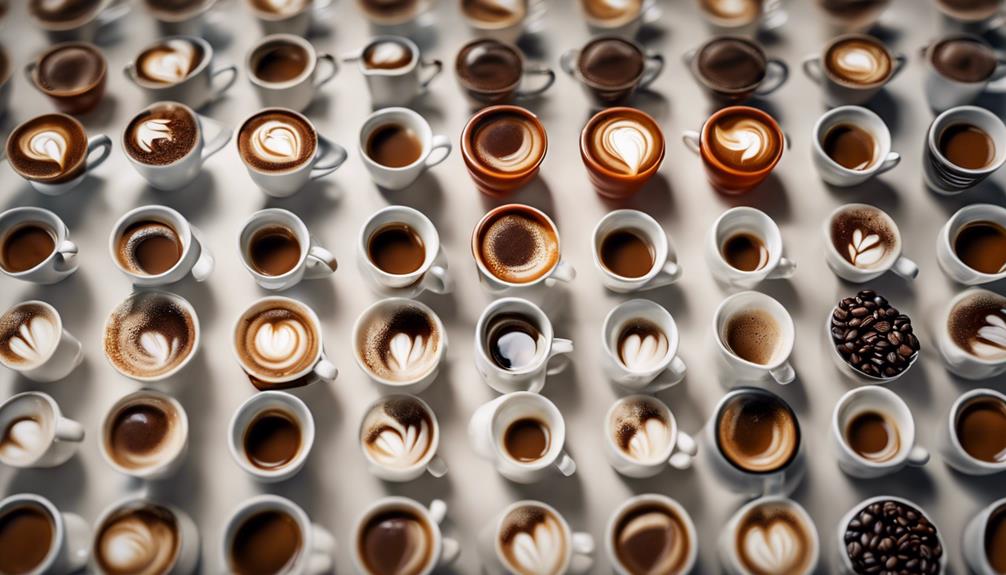
When you order your favorite espresso drink, the amount of caffeine you're getting can vary greatly depending on the coffee brand and type you choose. For instance, a single shot of espresso at Starbucks contains approximately 75 mg of caffeine, while a double shot has around 150 mg.
If you prefer Caribou Coffee, their medium brewed coffee has 305 mg of caffeine, and their caffe Americano (medium) contains 270 mg. Interestingly, brewed decaf coffee at Caribou has only 5 mg of caffeine, considerably lower than regular coffee options. The Depth Charge drink at Caribou has the highest caffeine content, totaling 370 mg for a medium size.
Even within the same brand, the caffeine content in espresso drinks varies. For example, a mocha can have 90 mg for a short size and up to 180 mg for a venti size due to added chocolate.
It's crucial to be aware of the caffeine content in your coffee drinks, especially if you're using an espresso machine or brewing coffee per cup. Understanding the level of caffeine in your coffee can help you make informed choices about your daily coffee intake.
Reducing Caffeine Intake Strategies
You can take control of your caffeine intake by employing a few simple strategies to reduce the amount of caffeine in your espresso drinks.
To reduce your caffeine intake, try the following:
- Opt for smaller serving sizes: Limit your espresso shots to reduce caffeine content per serving.
- Transition to decaf: Decaf coffee options contain considerably less caffeine, making them a great alternative.
- Limit espresso shots per drink: Fewer shots mean less caffeine in your beverage.
- Experiment with additives: Incorporating milk or other ingredients can dilute the caffeine content per serving.
Frequently Asked Questions
How Much Caffeine Is in 1 Espresso From Starbucks?
You're wondering how much caffeine is in 1 espresso from Starbucks? Well, you'll get around 75 mg of caffeine in a single shot of espresso, which is the standard amount in their tall drinks.
Is Espresso Healthier Than Coffee?
You're wondering if espresso is healthier than coffee, and the truth is, both have similar health benefits, rich in antioxidants and linked to reduced disease risks, so it ultimately comes down to your personal taste and caffeine tolerance.
How Much Coffee Is in I Shot of Espresso?
You're wondering how much coffee is in one shot of espresso? Think of it this way: a single shot packs the punch of about 7-10 cups of brewed coffee, condensed into a tiny 1-ounce serving!
How Much Espresso Is OK in a Day?
You can safely enjoy up to 2-3 shots of espresso daily, but it depends on your individual tolerance and caffeine intake from other sources.
What Are the Health Effects of Consuming High Caffeine Levels in Espresso?
The caffeine content in espresso shot can have both positive and negative effects on health. Consuming high levels of caffeine can lead to increased alertness, improved concentration, and enhanced physical performance. However, it can also cause anxiety, restlessness, and disrupted sleep. Moderation is key in consuming espresso for overall health.
Conclusion
As you savor the last drop of your espresso, remember that the caffeine coursing through your veins is just the tip of the iceberg.
Like a masterfully crafted puzzle, the pieces of coffee beans, roast levels, and brewing techniques come together to create a complex picture of caffeine content.
Now, armed with knowledge, you hold the key to revealing the perfect balance of flavor and energy – the ultimate prize for coffee connoisseurs.
